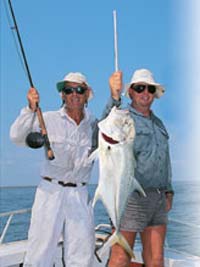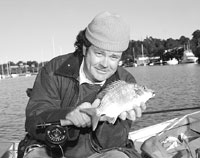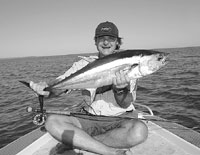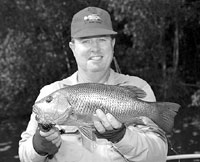Fly fishing - getting started
by Bob Hart
Fly-fishing, whether it is in fresh or salt water, is one of the fastest-growing sports in Australia. Bob Hart explains how we can get started in this satisfying and rewarding recreation.
 Fly rods and lines are divided into numbered categories by measurements called AFTMA (American Fishing Tackle Manufacturers Association) standards. These standards are based on the working part of the line or the first nine metres, exclusive of tip on a taper - the higher the number, the heavier the line and rod. The weight of the line and rod you wish to purchase is determined by three factors: the size of the fly you wish to use, the size of the fish you will encounter and the strength of the wind.
Fly rods and lines are divided into numbered categories by measurements called AFTMA (American Fishing Tackle Manufacturers Association) standards. These standards are based on the working part of the line or the first nine metres, exclusive of tip on a taper - the higher the number, the heavier the line and rod. The weight of the line and rod you wish to purchase is determined by three factors: the size of the fly you wish to use, the size of the fish you will encounter and the strength of the wind.
Unlike conventional tackle, where the weight of the lure pulls out the line, it is the weight of the line that casts the fly. Therefore, if fish are taking large wind-resistant flies, the angler will have to use a heavier fly line to cast these flies. Furthermore, if it is a windy day, the angler here too must use a heavier line to combat the windy conditions. Lastly, if big, powerful fish are encountered, the fly fisher must turn to a stronger rod to achieve success.
The line
The most important piece of equipment in fly-fishing is the fly line. As stated earlier, it is what casts the fly. Buy only the best quality line. Top-quality fly lines last longer and cast better and to buy cheaper, inferior lines is just bad economy. Fly lines have three to four sections, depending on the type of line: the forward taper, the working part of the line called ‘the belly’, the rear taper (not on all lines) and the running line.
Fly lines come in a variety of styles, but the most popular one is the weight forward floating line. This is the easiest line to cast and certainly the most practical in freshwater situations. This line comes in a variety of tapers, but, generally speaking, if you are after trout, then a long tapered line is for you. This type of line will give you not only a gentler presentation, but will also enable you to make longer casts.
 If heavy or bulky flies need to be used, then a short tapered line will make casting easier. However, these lines land heavily on the water and are not suited for nervous fish. There are of course many other types of fly lines such as intermediate, sinking tip, sinking and shooting-head lines, but these are harder to cast and therefore I think it is best that the beginner starts with the easiest casting line - the weight forward floating line.
If heavy or bulky flies need to be used, then a short tapered line will make casting easier. However, these lines land heavily on the water and are not suited for nervous fish. There are of course many other types of fly lines such as intermediate, sinking tip, sinking and shooting-head lines, but these are harder to cast and therefore I think it is best that the beginner starts with the easiest casting line - the weight forward floating line.
The rod
A 5- or 6-weight rod is a good choice for the beginner. Firstly, it is a lightweight rod to hold and secondly, it makes for an all-around trout rod. Plus, it can be used for light saltwater fishing as well. If the angler plans to participate in only tropical saltwater estuarine fishing, then an 8- or 9-weight rod will be a better choice. A good length for a fly rod is from eight and a half to nine feet in length and this should cover most fishing situations.
The reel
In freshwater fishing, the reel is the least important piece of equipment. It is really there to store the line. Freshwater reels that have a simple clicker for a drag will do quite nicely. However, if you prefer something a little more fancy, then you may chose a reel with a calliper or disc drag. The choice is yours.
 Reels for saltwater fishing should be highly resistant to saltwater corrosion. These reels are more robust than their freshwater cousins. Furthermore, saltwater reels should have a smooth drag, as saltwater fish generally pull a lot harder than freshwater species. The economical models have calliper drags, while the more expensive reels have cork drags. Most reels have direct drive, which means when line is being taken by the fish, the handle on the reel will spin backwards. Fly reels are not geared. They have a 1:1 ratio and rely on the reel’s large diameter to retrieve line rapidly.
Reels for saltwater fishing should be highly resistant to saltwater corrosion. These reels are more robust than their freshwater cousins. Furthermore, saltwater reels should have a smooth drag, as saltwater fish generally pull a lot harder than freshwater species. The economical models have calliper drags, while the more expensive reels have cork drags. Most reels have direct drive, which means when line is being taken by the fish, the handle on the reel will spin backwards. Fly reels are not geared. They have a 1:1 ratio and rely on the reel’s large diameter to retrieve line rapidly.
Large arbor reels are gaining popularity with today’s saltwater fly fisher. The arbor pertains to the axle or beam of the spool. A large reel can be made lighter by increasing the size of the arbor and the width of the spool. The spool resembles the rim of a wheel - it’s hollow inside. Therefore, a light, large diameter reel can be used on a light fly rod. There is less winding for the fly fisher with the large arbor reel and especially so when there is a copious amount of line to be reeled in.
Backing
Before you can wind your fly line onto your reel, you will first have to wind on backing line. Most fly lines are only 30 metres long. If a large fish takes all the fly line from the reel, the backing line will enable the angler to land the fish. The amount of backing a reel can hold is called its line capacity.
 A few years ago backing was only made from Dacron, but in today’s high-tech world, it is made from a petrochemical product called gel-spun polyethylene. Especially in saltwater fishing situations, this product has decided advantages over its predecessor, namely it doesn’t absorb water, it is unaffected by ultraviolet rays, it is rot resistant, it has little stretch and it is much thinner in diameter - hence, it will give a reel greater line capacity.
A few years ago backing was only made from Dacron, but in today’s high-tech world, it is made from a petrochemical product called gel-spun polyethylene. Especially in saltwater fishing situations, this product has decided advantages over its predecessor, namely it doesn’t absorb water, it is unaffected by ultraviolet rays, it is rot resistant, it has little stretch and it is much thinner in diameter - hence, it will give a reel greater line capacity.
I think the most valuable suggestion I can give the beginning fly fisher is to buy equipment from a fly-fishing shop run by very experienced fly fishers. Tell the salesclerk where you intend to do most of your fishing and what you intend to catch and this will greatly help in the selection of tackle you will need.
A good fly-fishing shop can also arrange fly casting lessons for the budding fly angler. Fly-fishing is a very rewarding and enjoyable pastime, which once started by the inquisitive sportsman, could become his passion. Good luck and tight lines.
